Woodborers comprise a diverse group of insects whose larvae typically feed on and bore into the wood of trees and other woody plants. They can be classified into several major categories based on their taxonomic families and biological characteristics. The primary types of woodborers include beetles, wasps, moths, and termites, each with distinctive habits and life cycles.
Call Us when you Need Help!
WOODBORER
Woodborers are a diverse group of insects known for their larvae, which primarily feed on and bore into the wood of trees and other woody plants. These insects play critical roles in forest ecosystems by contributing to nutrient cycling, facilitating decomposition, and impacting forest dynamics. The significance of woodborers extends beyond ecological functions, as their feeding behaviors can lead to severe damage in living trees and wooden structures, making them notable pests in both natural and managed environments.
The woodborer category encompasses various insect families, including beetles, wasps, moths, and termites, each exhibiting unique feeding habits and life cycles. Notably, woodborers can be classified into major groups such as longhorned beetles (Cerambycidae), metallic wood borers (Buprestidae), and wood wasps (Hymenoptera), among others. While some woodborers are integral to forest health, others, like the emerald ash borer, have been recognized for their destructive potential, causing significant mortality among tree populations and posing challenges for forest management and conservation efforts.
The damage caused by woodborers can manifest in various ways, including branch dieback, structural weakness, and reduced market value of timber. Infestations often compromise a tree’s vascular system, leading to increased susceptibility to diseases and potentially resulting in tree mortality. Moreover, aggressive woodborer species can inflict more substantial damage, making timely identification and management crucial for maintaining tree health and preserving wooden structures.
Controversies surrounding woodborers often arise from the balance between their ecological roles and their impact as pests. While their activities are essential for nutrient recycling and forest regeneration, the economic implications of woodborer infestations, particularly in urban areas and timber production, have led to debates over pest management practices. Effective control strategies must integrate biological, chemical, and cultural approaches to minimize environmental impact while protecting valuable resources from these wood-boring insects
Biology and Life Cycle
Taxonomic Hierarchy
Woodborers are a diverse group of insects that primarily feed on wood and plant material, playing significant roles in forest ecosystems. Their life cycles typically consist of four main stages: egg, larva, pupa, and adult. The duration of each stage can vary greatly among species and is influenced by environmental conditions, with the larval stage often lasting the longest, from one to three years
Bark Beetles
Adult bark beetles bore into tree bark, creating tunnels where they lay small, white, oval-shaped eggs. The larvae, which are also white, feed on the phloem within the inner bark, causing significant damage to their host trees. They will pupate within the tree and emerge as adults to find new trees, allowing the cycle to continue. The entire life cycle can be completed in 30 to 40 days, with some species capable of producing up to seven generations in a single year. The larvae or adults of various species can overwinter in the host trees, depending on the species
Buprestids (Metallic Wood Borers)
Buprestids exhibit a similar life cycle, where females lay eggs on or within weakened trees. The larvae burrow into the wood to feed and grow, often for a duration of one to three years, depending on the species and conditions. Their feeding can lead to considerable structural damage to the host, impacting the tree’s health and vitality. Upon pupation, adults emerge to seek out new hosts, continuing the life cycle.
Locust Borers
Locust borers, specifically Megacyllene robiniae, are active from spring to early July, with females laying hundreds of eggs within two weeks of emergence. The tan, oval eggs hatch after one to two weeks, and the larvae begin to tunnel under the bark, feeding on various layers of the trunk. These larvae overwinter within their tunnels and pupate in the early spring, with adults emerging later in the season, often leaving their pupal casings hanging from the tree trunk. Locust borers typically produce one generation per year
Pinyon Needle Scales
Pinyon needle scales lay eggs in clusters on the tree trunk and branches, which hatch into mobile nymphs called crawlers
Western Tent Caterpillars
The life cycle of western tent caterpillars begins with egg masses that overwinter on host trees. Upon emergence in the spring, larvae create silk tents for protection and feed on leaves. After several weeks, they pupate and emerge as adults, completing one generation per year. The synchronization of their emergence with bud break of host trees maximizes their feeding opportunities during the growing season. Through their unique feeding habits and life cycles, woodborers contribute to ecological processes such as nutrient cycling and forest succession, highlighting their significance in forest health and dynamics
Types of Woodborers
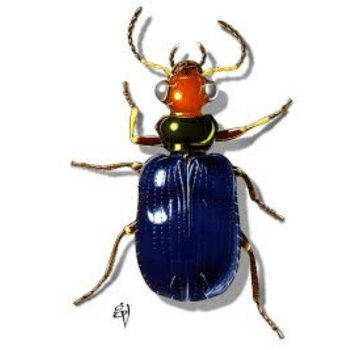
Beetles (Coleoptera)
Beetles represent one of the most diverse groups of woodborers.
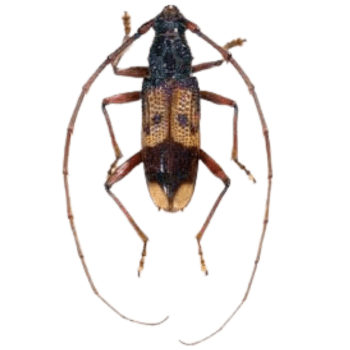
Longhorned Beetles (Cerambycidae)
Known for their long antennae, longhorned beetles are medium to large-sized insects that often display a brown or gray coloration, although some exhibit vibrant patterns. The adult female typically chews a pit in the bark to lay her eggs, and the larvae, commonly referred to as roundheaded borers, are pale with dark jaws and a rounded body shape
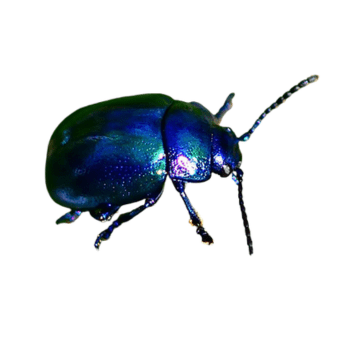
Metallic Wood Borers (Buprestidae)
This group includes species such as the golden buprestid and the western cedar borer, characterized by their shiny, metallic appearances. Their larvae burrow into the wood, causing significant damage to trees and timber
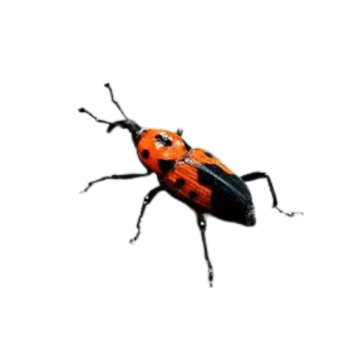
Weevils (Curculionidae)
While most weevils are not considered wood borers, certain species, such as the poplar and willow borer, are noteworthy for their wood-boring habits. These insects typically infest small diameter trunks, leaving behind coarse sawdust-like excrement as an indicator of their presence
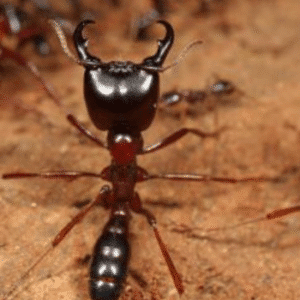
Wasps (Hymenoptera)
Wood wasps, or horntails, are large wasps that typically infest freshly killed trees. They lay their eggs in solid wood using a specialized ovipositor. The larvae create tunnels within the wood, but these wasps are generally not considered serious pests
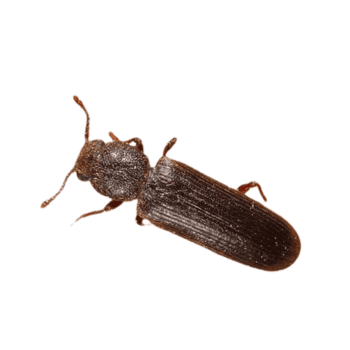
Lyctidae (True Powderpost Beetles)
Several families of moths are known for their wood-boring larvae:
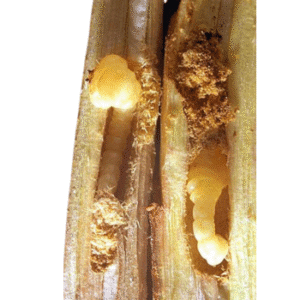
Flat-headed Borers
Carpenterworm larvae, such as those of the carpenterworm moth (Prionoxystus robiniae), are particularly destructive, tunneling deep into the trunks of various deciduous trees. Their life cycle can be notably lengthy, taking 3-4 years to mature
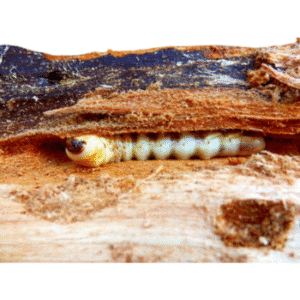
Round-headed Borers
Clearwing borers resemble wasps due to their lack of scales on their wings. This mimicry helps them evade predation. They lay eggs on the bark’s surface, and their larvae bore into the wood, often going unnoticed until significant damage occurs
Identification and Symptoms of Infestation
Identifying woodborer infestations is crucial for effective management and prevention strategies. Woodborers, a diverse group of insects, can significantly impact both living trees and wooden structures. Recognizing the signs and symptoms of infestation allows for early intervention, which can prevent severe damage and even tree death.
Signs of Infestation
The presence of woodborers is typically indicated by various physical signs on the host tree.
- Emergence Holes: These holes are created by adult woodborers as they chew through the bark and exit the tree. The size and shape of these holes vary depending on the species; for example, exit holes from the emerald ash borer are distinctive and D-shaped, measuring approximately 3mm in diameter.
- Feeding Galleries: Under the bark, woodborer larvae create irregular and winding tunnels filled with frass (sawdust-like excrement) and debris. The presence of these galleries can compromise the structural integrity of the tree, making it more susceptible to other pests and diseases.
- Frass Accumulation: The fine sawdust produced by feeding larvae accumulates at the base of the tree or on the bark, serving as a clear sign of infestation.
- Gumming and Oozing: Infested trees may exhibit oozing wounds on the bark, which can be accompanied by sticky exudates. This is often a response to the damage caused by the woodborers.
Symptoms of Infestation
Symptoms refer to the tree’s response to the pest and can vary widely based on the species and level of infestation.
- Branch Dieback: Infested trees may show signs of branch dieback, where leaves turn yellow, drop prematurely, or show discoloration. This symptom is indicative of stress and poor health due to the feeding activities of the larvae.
- Weakened Wood Structures: As woodborers tunnel through the wood, they compromise its structural integrity, leading to increased vulnerability to wind damage and wood-rotting organisms.
- Epicormic Branching: In response to stress, trees may produce excessive lateral shoots, known as epicormic branches, as a survival mechanism.
Monitoring for Infestation
Regular visual inspections of trees are essential for early detection of woodborer infestations. Monitoring should focus on both the trunk and branches, looking for the signs mentioned above. In addition to visual checks, the placement of traps can help in assessing the presence of specific woodborer species. Trapping should be done strategically, avoiding placement directly under tree canopies to maximize catch rates. By understanding and identifying these signs and symptoms, tree owners and managers can take timely action to mitigate the impact of woodborers, ensuring the health and longevity of affected trees.
Damage Caused by Woodborers
Woodborers, particularly in their larval stage, are significant pests that can inflict severe damage on living trees and wooden structures. The larvae typically tunnel and feed beneath the bark within the cambium layer, which is essential for the transportation of water and nutrients in trees. This feeding behavior disrupts the tree’s vascular system, leading to a variety of detrimental effects.
Effects on Living Trees
When woodborers infest healthy trees, they can cause extensive damage by destroying water and sap-conducting tissues, resulting in a process known as girdling. Girdling severely impacts the tree’s ability to thrive, leading to symptoms such as branch dieback, structural weakness, and overall decline. Furthermore, the stress inflicted on trees can make them more susceptible to diseases and can ultimately result in tree mortality.
Structural Impacts on Wood Products
Beyond affecting living trees, woodborers also pose a threat to wooden products. Tunneling by woodborers into the heartwood can degrade the quality of timber and decrease its market value. In furniture and flooring, visible signs of wood borer damage include crumbling edges and spongy floorboards, which indicate compromised structural integrity due to extensive tunneling.
Aggressive Woodborers
Certain species of woodborers are particularly aggressive and can inflict more substantial damage than others. For instance, the peachtree borer, Zimmerman pine moth, and emerald ash borer are examples of woodborers that have been reported to cause significant harm to trees in specific regions, such as Colorado. However, it is essential to note that many woodborers can only infest trees that are already stressed or damaged, often targeting trees affected by prior wounds, fungal infections, or other environmental stressors.
Ecological Role and Implications
While the damage caused by woodborers is considerable, they also play a crucial ecological role in forest ecosystems. Woodboring beetles aid in the decomposition of dead or weakened trees, facilitating nutrient recycling within disturbed forest stands. This ecological function is particularly relevant following large-scale disturbances, such as wildfires or severe storms, where the mortality of trees creates habitats for woodborers and other decomposers
. Understanding the complex dynamics of woodborer infestations is vital for forest management and pest control strategies, especially as global changes, such as climate change, can influence the prevalence and impact of these pests on forest health
Control and Management
Effective control and management of wood borers require a comprehensive approach that integrates multiple strategies, including physical, biological, chemical, and cultural controls. These methods aim to reduce wood borer populations while minimizing adverse impacts on the environment and economic resources.
Physical Control
Physical control methods involve direct intervention to manage wood borer infestations. One of the primary techniques is the application of barrier treatments on tree trunks, which are designed to prevent borers from accessing the trees or to intercept larvae before they enter. Although these methods are labor-intensive and not commonly used in production nurseries, they can be effective for protecting valuable specimen trees in landscape settings. Barrier treatments must be applied proactively, and their effectiveness depends on persistence and the frequency of reapplication
Biological Control
Biological control leverages natural enemies to manage wood borer populations. This can involve the use of parasitoids, such as wasps and flies, which prey on wood borer larvae. Successful programs have introduced natural enemies in regions where specific borer species are not native, enhancing the local ecosystem’s ability to regulate pest populations. Additionally, nematodes can be employed as biological control agents, injected through holes in the tree to target larvae within the wood
Chemical Control
Chemical control methods involve the application of insecticides to manage wood borer populations. Common strategies include trunk injections, which deliver insecticides directly into the tree’s vascular system, and trunk sprays that create a barrier against incoming borers. Timing is crucial for chemical applications, often guided by monitoring trap captures to identify peak infestation periods. Bifenthrin and permethrin are widely used synthetic pyrethroid insecticides for controlling borers, alongside other products like spinosad and chlorantraniliprole
. It is essential to follow label instructions for appropriate use in different environments, such as nurseries versus landscapes.
Cultural Control
Cultural control practices focus on improving tree health and resilience to prevent infestations. Maintaining vigorous, healthy trees through proper silviculture, such as appropriate watering and planting techniques, can mitigate stress that attracts wood borers. Additionally, removing infested or dead trees can help prevent the spread of infestations. The use of resistant tree species or cultivars is also a proactive strategy to reduce the likelihood of borer attacks
Monitoring and Detection
Monitoring and detection are critical components of an effective wood borer management strategy. Techniques include visual surveys for signs of activity, such as exit holes and frass, along with trapping methods that can help gauge the presence and density of borer populations. Sampling methods, including branch sampling and trunk injections, provide further insights into the extent of infestations
Ecological Roles of Woodborers
Woodborers, a group of insects that feed on wood, play significant ecological roles in forest ecosystems, contributing to processes such as nutrient cycling, gap formation, and the overall dynamics of forest structure.
Nutrient Cycling
Woodborers are instrumental in the fragmentation of woody material and the initiation of nutrient cycling. Through their feeding and tunneling behaviors, they break down wood, facilitating the decomposition process and making nutrients available for other organisms within the ecosystem. This breakdown is vital for sustaining soil health and promoting plant growth as it leads to the release of soluble forms of nutrients that can be readily absorbed by plants
Impact on Forest Structure and Dynamics
At a broader scale, woodborers influence forest structure by creating light gaps. These gaps not only allow for increased sunlight penetration but also promote biodiversity by providing habitats for various species. Furthermore, the activities of woodborers can alter the dynamics of succession in temperate ecosystems, as the decomposition of dead wood and the subsequent nutrient release can facilitate the establishment of new plant species
Interactions with Other Organisms
In addition to their direct effects on nutrient cycling and forest structure, woodborers expose wood to a variety of other organisms, including fungi and bacteria, which play essential roles in the decomposition process. This interaction contributes to a complex web of ecological relationships that supports diverse life forms within forest environments.
Cockroach Control and Management
Controlling cockroaches is a multifaceted challenge due to their resilient nature and adaptability to various environments. Traditional methods, such as over-the-counter sprays, may often fall short against these pests, especially as many cockroach populations develop resistance to common insecticides. Therefore, effective cockroach management involves a comprehensive approach that combines chemical treatments with preventive measures.
Preventive Measures
Effective cockroach control necessitates more than extermination; it requires a holistic strategy. Preventive measures play a crucial role in minimizing the risk of infestation.
- Proper food storage, using airtight containers to prevent access.
- Regular cleaning to eliminate food residues and potential hiding spots.
- Sealing entry points to reduce access to indoor environments.
- Public education on cockroach biology and behavior to empower residents and business owners to take proactive steps
Community Involvement
In multi-family units, collaboration among residents, management staff, and pest control companies is vital for effective cockroach management. Residents are encouraged to maintain sanitary conditions, report infestations, and regularly clean their spaces. Management staff should address maintenance issues, such as fixing water leaks, which can provide essential resources for cockroaches. By eliminating food, water, and hiding places, infestations can be significantly reduced.
Monitoring and Identification
Monitoring the presence and distribution of cockroaches is the first step in any management program. Visual inspections are a straightforward method to identify potential infestations. Key areas for inspection include kitchens, bathrooms, and locations near food and water sources, using a flashlight to aid in the search. For more thorough monitoring, several tools can be employed:
- Jar traps: A simple method involving a baby food jar with a greased upper portion to trap cockroaches attracted to bait placed inside.
- Glue board traps: Strategically placed in areas where cockroaches are likely to frequent, such as kitchen cabinets and near garbage cans, these traps help assess infestation levels.
Integrated Pest Management
An Integrated Pest Management (IPM) approach is recommended to effectively manage cockroach populations.
- Sealing gaps in plumbing and structural elements.
- Reducing ambient moisture through improved ventilation and drainage.
- Conducting routine inspections and applying treatments as necessar
- . Furthermore, educating residents on proper sanitation practices is essential for interrupting the cockroach lifecycle and aiding in do-it-yourself control efforts
Chemical Control Methods
Chemical treatments may include traditional insecticides and Insect Growth Regulators (IGRs), which disrupt the growth and reproductive cycles of cockroaches. Unlike conventional insecticides, IGRs prevent pests from reaching maturity and thereby reduce population growth over time
Interaction with Humans
Rats have increasingly become popular as pets due to their social nature and intelligence. Unlike the common perception of rats as pests, domesticated rats can form strong bonds with their human caregivers. Proper husbandry is critical to ensure the health and happiness of pet rats, as many basic care needs are often overlooked, leading to diseases and suffering among these animals
Social Behavior
Rats are inherently social creatures that thrive in the company of others. They exhibit complex social interactions, including grooming, play fighting, and establishing a hierarchy within their group
. Rats are known to bond closely with their human owners as well, showing affection through behaviors such as licking and cuddling. They communicate their feelings through body language, vocalizations, and even subtle gestures. For instance, rats may “brux” (grind their teeth) when they are content or huddle together to indicate a sense of safety
Impact of Human Interaction
The quality of interaction between humans and rats plays a significant role in their overall well-being. Positive experiences and regular handling can help reduce stress levels and encourage the development of trust between rats and their owners Rats that experience social stress during their formative years may show behavioral issues later, affecting their relationships with both humans and other rats
10% Discount: Applied automatically for first-time bookings.


